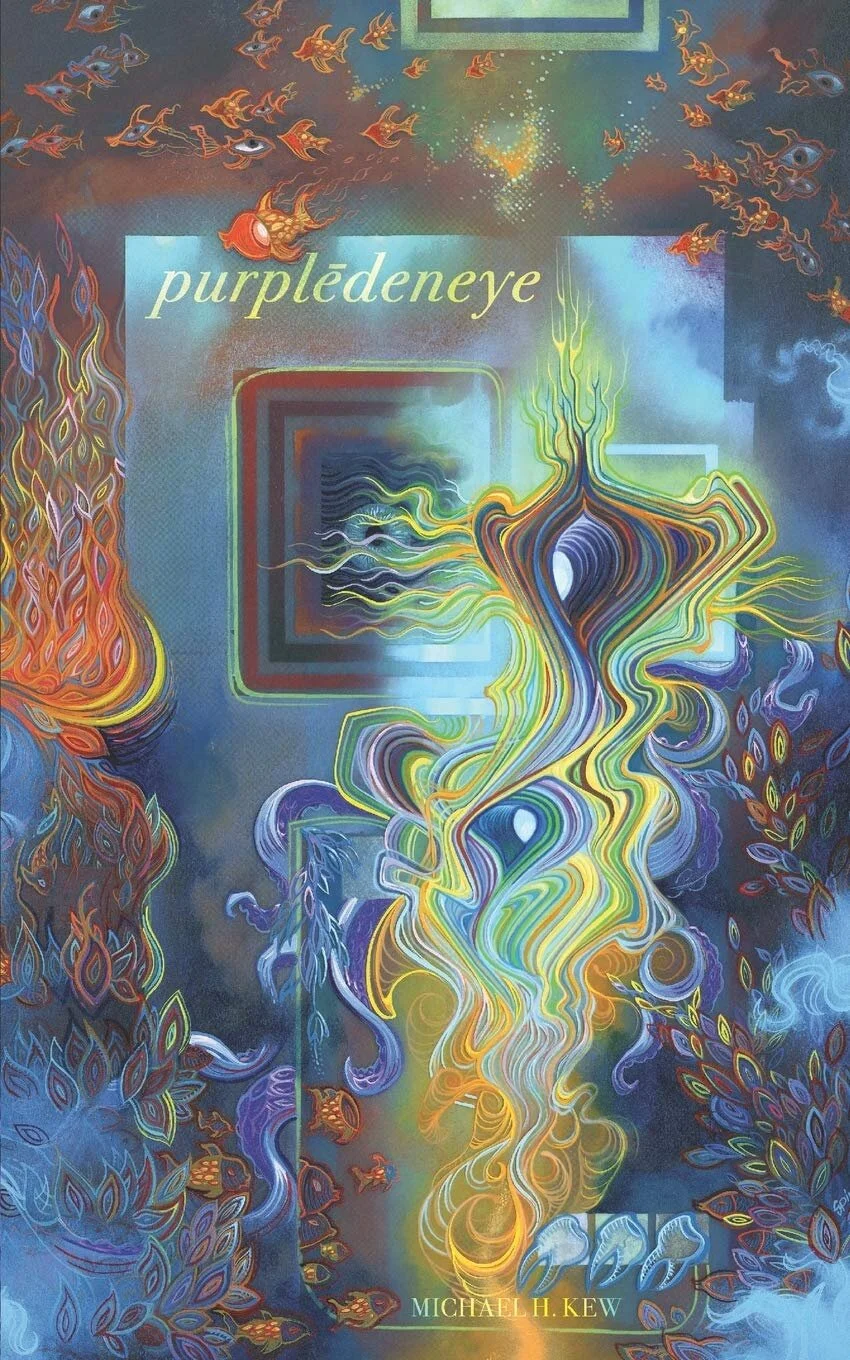Purplēdeneye
By Michael H. Kew
Twenty-twenty was to be my fat fertile year pimping Rainbownesia and Nectars of Sky. Myriad sales, signings, readings, slams, fests—months of general gaiety and hobnob abundance spanning the U.S. West Coast, British Columbia, Hawai’i, points Atlantic, aims of Europe and the Trans-Tasman. For me, an ambivert weaving a pseudomonastic life in the coastal mountains of southern Oregon, the books promised a depth of opportunity, a rejuvenating social manifest. Four author appearances occurred in late winter. Then the world shut down.
By April I’d begun chronicling fragments of my increasingly vivid dream journeys, not deliberately to craft new works but to interpret per curiosity as most were quite lively and communal—a sharp contrast to the wacky anthroreality unfolding. Subconsciously I was living vigorously. There were no lockdowns, no hint of face masks nor hand sanitizing-six feeting-societal suffocating-quagmired quarantining. Rather: smiles, laughter, wild parties, music concerts, beach gatherings, pubbing, womening, world traveling, odd yet delightful scenarios—my nocturnality depicted merry normality while 2020 burst into a wide dinurnal stink of nightmare.
One rainy May dusk with a glass of Humboldt petite sirah, I browsed my new copy of The Penguin Book of Oulipo, a lush 400-page anthology of exotic poetic structures and techniques exemplifying the Oulipo, or Ouvroir de Littér hature Potentielle (Workshop of Potential Literature), founded in 1960 by writer Raymond Queneau and mathematician François Le Lionnais, two brilliant Frenchmen who elected unique individuals into what became a small eccentric core of giant minds. One, Jacques Roubaud, summarized Oulipo thus: “The aim is to invent (or reinvent) constraints of a formal nature and propose them to enthusiasts interested in composing literature.” New York-based Academy of American Poets boiled Oulipo doctrine down to “the profound potential of a poem produced within a framework or formula and that, if done in a playful posture, the outcomes could be endless.”
To that end(less?), equipped also with cherished copies of Harry Mathews’s Oulipo Compendium (an Oulipo dictionary), William Gillespie’s weirdo Oulipoish Table of Forms, and Edward Hirsch’s iconic A Poet’s Glossary, spontaneously I resolved to distill my waxing collection of dream notes, eventually whittling 55 of them into 55 poems per 55 structures, 55 a Fibonacci number (indeed the works in Nectars of Sky totaled 89, successive in that sacred sequence).
Whereas—
Sequentially, dreams sing sweetly for but a few years inside of us. Recollected or not, in the average human lifespan we drift through enigmas several times nightly (or daily, depending), most individual dreams lasting from five to 20 minutes and never in exclusive grayscale as once believed.
Hence—
Eternal queri: why do we dream? what are dreams? why do we dream
what we dream? why do we dream what we dream when we dream? what do dreams mean, if anything? does it matter? do we care? should we care? are they antiphonic duels—or harmonies—‘twixt consciousnesses? psycho-anaphora? quasi-psychedelia? hallucination? prophetic déjà vu? (like many of mine.)
Here in the West, British neurowhiz Oliver Sacks failed to divine these mysteries. He and others published serious tomes, studies, essays, pontifications, analyses. And to what end? Austria’s Freud proffered meat with his holy trinity (id, ego, superego) as personal wish-fulfillment, dreams our “royal road to the unconscious.” Per individuation, Freud pupil Jung the Swiss implied dreams were missives from the inner (unconscious) to the outer (conscious) worlds however they corresponded with each other.
Both men fleshed a mind-scale of four tiers:
conscious fueled by ego
preconscious data at the ego’s disposal
personal unconscious instinct; Freud’s id
collective unconscious Jung’s “vast historical storehouse of the human race”
Via the latter and quite similarly, German psychiatrist/psychotherapist Fritz Perls employed his own gestalt (“form” or “pattern”) theory, i.e. the whole of anything is greater than its parts, e.g. dreams are neglected cogs of our psyche and issues repressed by awake time. Whiffs of rhythmic logic and reality could be glued to recurring topics and scenarios based on conscious emotions and occurrences when our thought channels are laid bare, our brains unleashed from external influence—multivalent motifs pursuing cross-psychic dimensions.
Modernly, American psychiatrist-psychoanalyst J. Allan Hobson and British neuroscientist Karl Friston hatched a plausible fact-heavy hypothesis: based on your dreambrain activity during REM (rapid eye movement) cycles, overall it is a simulation device crafting a virtual reality of your waked environs. And so, through the hole of my REM iris churned unforeseen holographic visions/truisms, often forgotten upon or shortly after I woke, the breathlessly bizarre, the serene, even the disturbing ephemera that I sought to record and decipher for their amaranthine omens. Or provenance. Or zaniness. Or‚ more empiric, for their 20/20 nowsights.
Available in paperback from Amazon.



